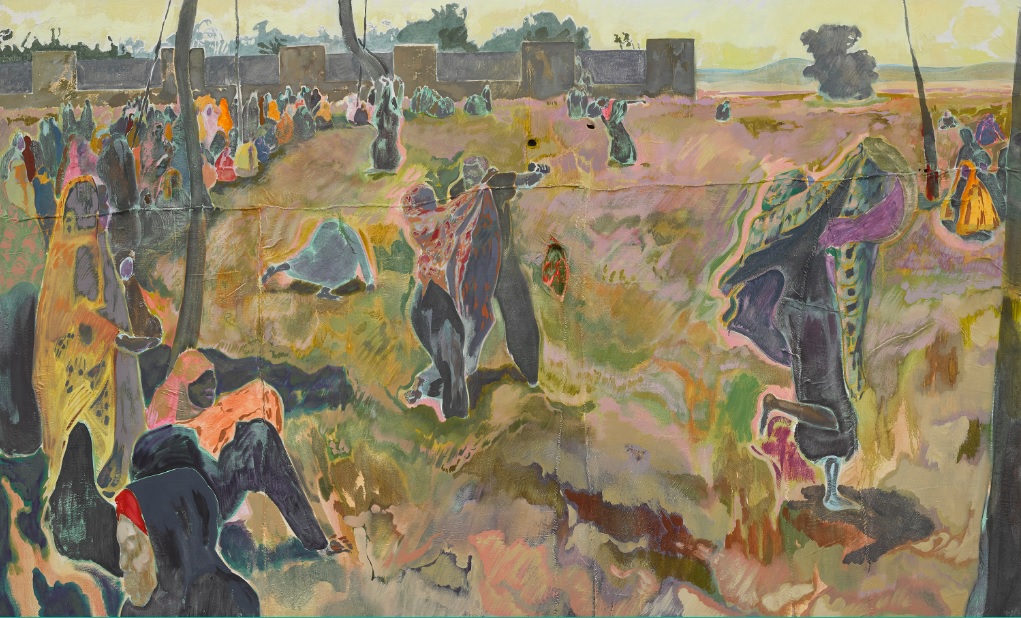


Michael Armitage, Exorcism, 2017, © Michael Armitage. Photo © White Cube (Ben Westoby). Courtesy of the Artist and the Harry and Lana David Collection.
Michael Armitage’s show in South London opened a month ago, but perhaps at that awkward moment when many of us were beginning to panic in earnest about Christmas shopping, or pant for the end of year break, and may therefore have missed it. Fortunately, The Chapel continues for another few weeks until 23 February. It is a must-see.
Armitage’s paintings teem with incident and reference; you will need to slow yourself right down to explore each one, then retrace your steps and interrogate them all again. A painter trained in London, Armitage was born in Kenya and still spends up to half of each year there. His works often find their genesis in factual narratives drawn from contemporary Kenyan life, and use reference to some of the great masters of European painting to create unsettling and compelling images. Gauguin is the most obvious reference, but Picasso, Titian and Goya also feature.
Peter Doig is the most evident contemporary reference – in one painting Doig’s unmistakable canoe takes the foreground – and although he is not mentioned in any of the texts, the influence of Chris Ofili seems to hover somewhere not too far away. Where in the early 90s Ofili used varnished and painted balls of elephant dung on his paintings as signifiers of his connections to Africa, Armitage paints on traditional Ugandan lubago bark cloth. Stitched roughly together, the highly textured support for the oil paintings can become part of the composition.
In an interview with SLG Director Margot Heller, Armitage makes what is for me a key statement: “There’s something about a cliché that makes it very easy to dismiss ideas that are really quite problematic – that makes it very easy to look at things for the wrong reasons. Clichés make prejudice easy to digest, prejudice that really needs to be broken down and given much more careful consideration.”
The clichés he refers to could be lazy stereotypes of Kenyan, or African society, or the over-familiar motifs of excessively well-known European paintings. By bringing these into restless conjunction, Armitage serves up strange compositions - sometimes of brutality and oppression - and pulls apart tropes of African violence opposed to European civility.
The first painting in the show is the uncanny hope, 2017 which seems redolent of anything but optimism. The central figure is a young girl, an unreadable expression on her placid face. With her legs akimbo, a rope of blood streams from under her pink floral dress. It is not immediately clear whether she has just given birth to the long-lashed calf at her feet, or the miniature human figure tumbled into a basket in the foreground. In the top right corner, in the space that would be occupied by a dove in a medieval Annunciation, an automatic washing machine descends from clouds, borne not by a beam of celestial light, but what seems to be a fragment of a Jamaican flag.
While some of the paintings feature disturbing, hybrid figures that are part reptile and part human, Nyayo, 2017 creates an overwhelming sense of foreboding with only human figures. Once again there is a dominant central figure, in this case the sensuously rendered form of a naked man, his finely muscled upper body picked out in flashes of red and livid blue. In an echo of the Laocoön, he appears to be struggling to shake off the snake coiled tightly around his leg.
Let your eye wander to the perimeter of the canvas and suddenly your perspective is flipped. We, the spectator are hovering above this scene, looking down on the now-clearly prone naked man, and the tops of the heads of the men standing around him. We are observing the watchers. Look again and chilling details like the epaulettes on the shoulders of the men, the camo pattern of their trousers, take your attention.
The exhibition guide explains that in the 1990s, during the Moi era, it was the custom in Nairobi to throw toothless snakes into the cells of prisoners to terrify them into confessing. The voyeuristic set up, the vulnerability of the man amid these militaristic watchers, is as highly charged as it could be.
The largest painting in the show is The Flaying of Marsyas. It borrows its composition largely from Titian’s work of the same name, but transposes the scene of torture to a contemporary setting. Quite thinly painted, Armitage flattens the distance between figure and ground and creates an overall design which means one needs to work hard to make out what is going on.
The shock of the painting’s brutal subject arises partly from the tension between this and the delicacy of the handling of paint. The all-over design of the work recalls not only the self-conscious exoticism of Gauguin’s south sea paintings, but the overwhelming sensuality of patterning in 19th Orientalist paintings too. At the right hand edge of The Flaying of Marsyas a naked woman squats, her back to us, leering over her shoulder. She is, it seems to me, transposed directly from Picasso’s Les Demoiselles d’Avignon, one of two female figures that shocked all of Paris in 1907 by adopting faces from African masks.
Armitage has a remarkable facility as a painter, a command of colour and a seductive line. I for one will enjoy watching him continue to explore the territory he has claimed for himself.
Caroline Douglas
Director
South London Gallery, 65-67 Peckham Rd, London SE5 8UH. Tuesday - Sunday 11.00 – 18.00 except Wednesday and the last Friday of the month until 21.00. Closed Monday. Exhibition continues until 23 February 2018. www.southlondongallery.org